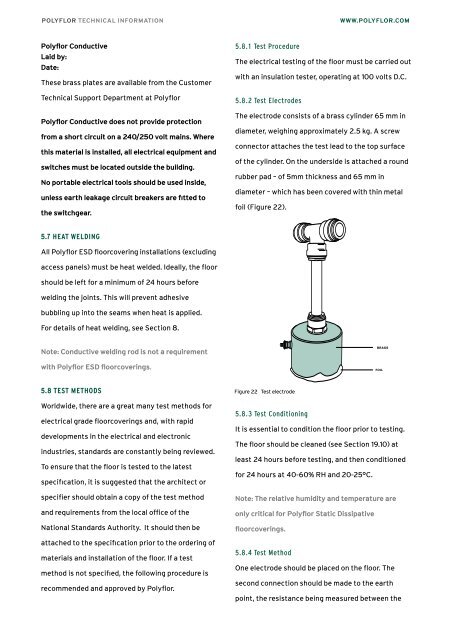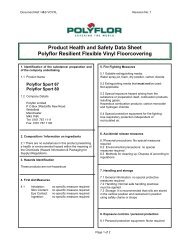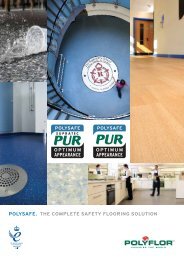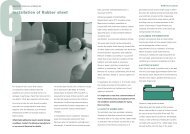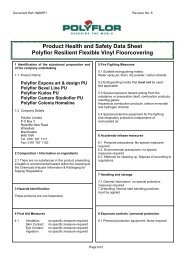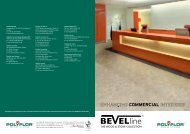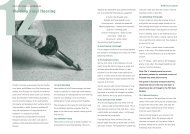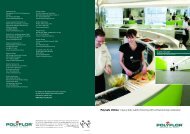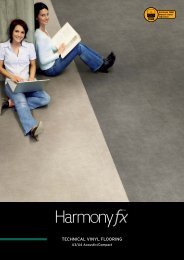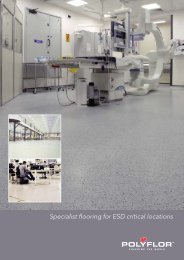floorcoverings - Polyflor
floorcoverings - Polyflor
floorcoverings - Polyflor
You also want an ePaper? Increase the reach of your titles
YUMPU automatically turns print PDFs into web optimized ePapers that Google loves.
POLYFLOR TECHNICAL INFORMATION<br />
WWW.POLYFLOR.COM<br />
<strong>Polyflor</strong> Conductive<br />
Laid by:<br />
Date:<br />
These brass plates are available from the Customer<br />
Technical Support Department at <strong>Polyflor</strong><br />
<strong>Polyflor</strong> Conductive does not provide protection<br />
from a short circuit on a 240/250 volt mains. Where<br />
this material is installed, all electrical equipment and<br />
switches must be located outside the building.<br />
No portable electrical tools should be used inside,<br />
unless earth leakage circuit breakers are fıtted to<br />
the switchgear.<br />
5.8.1 Test Procedure<br />
The electrical testing of the floor must be carried out<br />
with an insulation tester, operating at 100 volts D.C.<br />
5.8.2 Test Electrodes<br />
The electrode consists of a brass cylinder 65 mm in<br />
diameter, weighing approximately 2.5 kg. A screw<br />
connector attaches the test lead to the top surface<br />
of the cylinder. On the underside is attached a round<br />
rubber pad – of 5mm thickness and 65 mm in<br />
diameter – which has been covered with thin metal<br />
foil (Figure 22).<br />
5.7 HEAT WELDING<br />
All <strong>Polyflor</strong> ESD floorcovering installations (excluding<br />
access panels) must be heat welded. Ideally, the floor<br />
should be left for a minimum of 24 hours before<br />
welding the joints. This will prevent adhesive<br />
bubbling up into the seams when heat is applied.<br />
For details of heat welding, see Section 8.<br />
Note: Conductive welding rod is not a requirement<br />
with <strong>Polyflor</strong> ESD <strong>floorcoverings</strong>.<br />
BRASS<br />
FOIL<br />
5.8 TEST METHODS<br />
Worldwide, there are a great many test methods for<br />
electrical grade <strong>floorcoverings</strong> and, with rapid<br />
developments in the electrical and electronic<br />
industries, standards are constantly being reviewed.<br />
To ensure that the floor is tested to the latest<br />
specifıcation, it is suggested that the architect or<br />
specifier should obtain a copy of the test method<br />
and requirements from the local office of the<br />
National Standards Authority. It should then be<br />
attached to the specifıcation prior to the ordering of<br />
materials and installation of the floor. If a test<br />
method is not specifıed, the following procedure is<br />
recommended and approved by <strong>Polyflor</strong>.<br />
Figure 22 Test electrode<br />
5.8.3 Test Conditioning<br />
It is essential to condition the floor prior to testing.<br />
The floor should be cleaned (see Section 19.10) at<br />
least 24 hours before testing, and then conditioned<br />
for 24 hours at 40-60% RH and 20-25°C.<br />
Note: The relative humidity and temperature are<br />
only critical for <strong>Polyflor</strong> Static Dissipative<br />
<strong>floorcoverings</strong>.<br />
5.8.4 Test Method<br />
One electrode should be placed on the floor. The<br />
second connection should be made to the earth<br />
point, the resistance being measured between the


